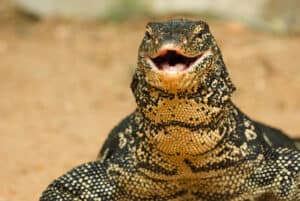The Iguanidae family of lizards is a diverse one made up of over 40 unique species of all different sizes, shapes, and colors. Ever wondered what the most colorful iguanas on the planet are? Below are 10 incredibly vibrant species ranging from shades of green, blue, red, orange, yellow, and even pink!
From the widespread green iguana to lesser-known species like the yellow-backed spiny-tailed iguana, you’ll be amazed at just how beautiful iguanas can be! Read on to learn more about the history of each species, where they live, what they look like, and more.
1. Green Iguana (Iguana iguana)

Green iguanas are some of the most vibrant lizards in the world.
©iStock.com/passion4nature
We start our list off with the handsome yet tragically invasive green iguana. Although it’s taken over parts of Florida and Texas over the past few decades, this species is actually native to parts of Mexico, Central America, South America, and the Caribbean Islands. Like many iguana species, green iguanas are arboreal herbivores, meaning they spend most of their time climbing trees foraging for leaves, vines, and flowers to feed on.
Despite their name, green iguanas have been selectively bred by reptile enthusiasts over time to display a wide range of unique colors, or “morphs,” from shades of blue and green to orange and even red. Interestingly, they’re some of the largest iguanas in the world! It’s common for them to reach lengths of 5+ feet and weigh 15+ pounds.
2. Fiji Banded Iguana (Brachylophus fasciatus)
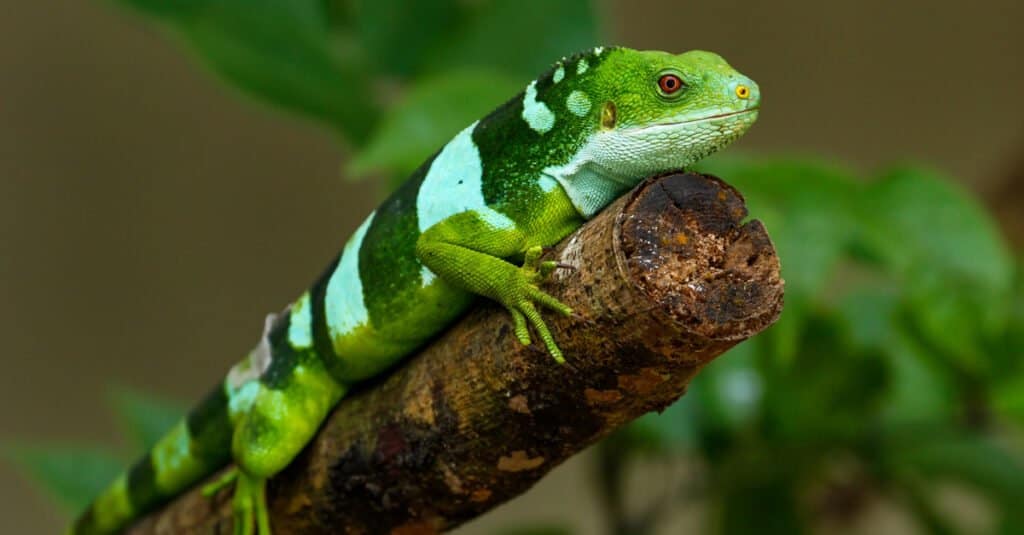
Fiji banded iguanas have colorful stripes across their bodies.
©Don Mammoser/Shutterstock.com
Also known as the Lau banded iguana, Fiji banded iguanas primarily reside on Fiji’s Lau Islands. These vibrant iguanas get their name from their pale bluish-white bands or stripes crisscrossing their bright green bodies. However, it’s common for these lizards to change their color slightly to blend in better with their environment to hide from predators, similar to chameleons!
Fiji banded iguanas are one of the smaller species within the Iguanidae family. On average, they reach lengths of around 20 to 24 inches and can weigh up to half a pound. They’ve become sort of a mascot for the Fijian Islands, a representative of the area’s colorful biodiversity. Sadly, their populations are declining due to habitat loss and predation by mongooses and local house cats. Today, they’re an endangered species.
3. Yucatan Spiny-Tailed Iguana (Cachryx defensor)
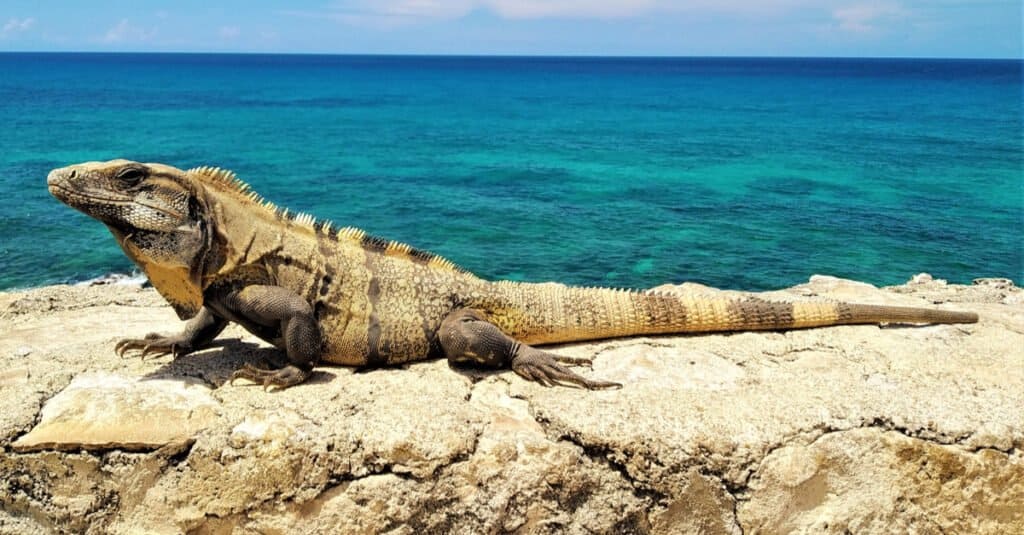
The Yucatan spiny-tailed iguana is the most colorful species of spiny-tailed iguana.
©phortun/Shutterstock.com
There are many fascinating kinds of spiny-tailed iguanas, but the Yucatan variety is possibly the most colorful of the bunch. Though most of its body is brown and grey, it has bright orange patches across its midsection. This unique coloration along with its wide, spiked tail makes the Yucatan spiny-tailed iguana a stunning sight to behold.
These diminutive iguanas are native to Mexico, though they have also become threatened by habitat loss over time. They’ve become somewhat popular in the pet trade recently thanks to their small size and docile temperament.
4. Grand Cayman Blue Iguana (Cyclura lewisi)
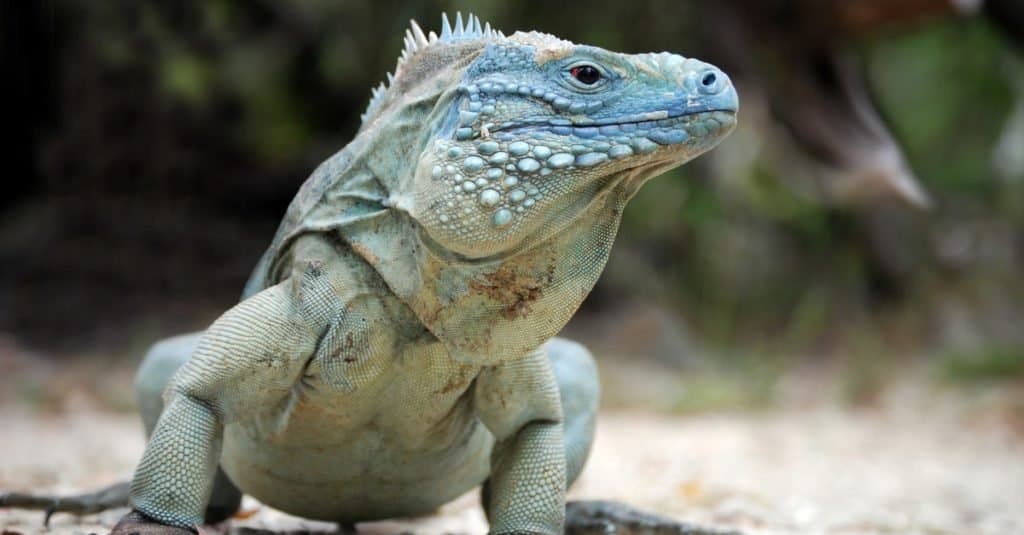
The Grand Cayman blue iguana actually ranges in color from grey to greenish-blue.
©Frontpage/Shutterstock.com
These massive lizards have many names, including the Grand Cayman rock iguana, Cayman blue iguana, or simply the blue iguana. Aside from their vibrant color, they are also impressive thanks to their large size. Both males and females commonly reach lengths surpassing 5 feet and can weigh up to a whopping 30 pounds!
Interestingly, Grand Cayman blue iguanas begin life rather dull in color and become more vibrant as they age. They also display slight sexual dimorphism! Males are usually blue or greyish-blue, while females tend to be mostly greenish-blue. Like many iguanas, these vivid lizards can change their color slightly, primarily to establish their dominance over other members of their species.
5. Red Iguana (Iguana iguana morph)
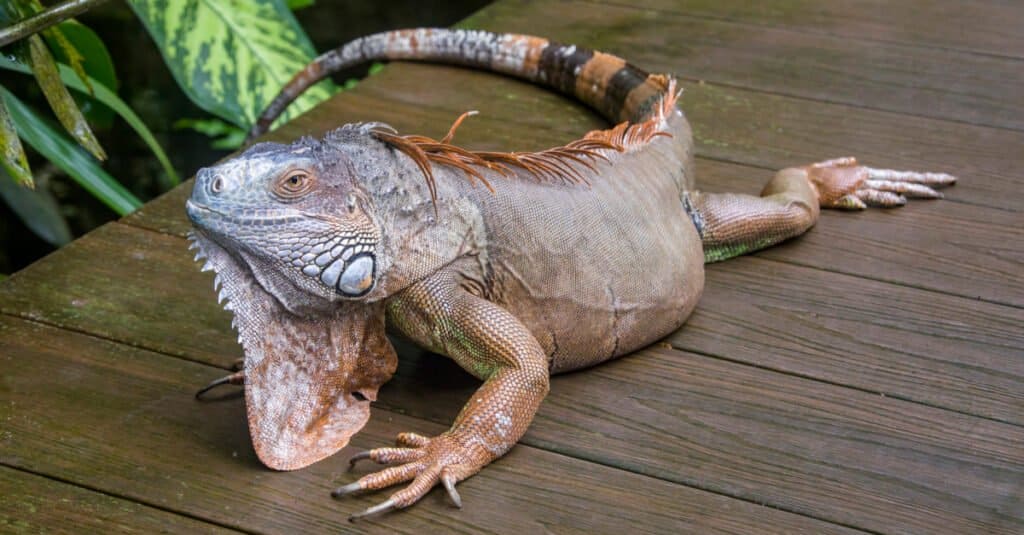
Red iguanas are one of the most colorful iguanas but they’re actually a “morph” of a green iguana
©Danny Ye/Shutterstock.com
While many reptile enthusiasts mistakenly believe red iguanas are their own unique species, they are actually a variant or “morph” of green iguanas. Like we touched on earlier, reptile breeders have carefully bred green iguanas to display various colors. As it turns out, red has become one of the most popular and sought-after varieties.
Ranging in color from deep, crimson red to neon orange, these handsome iggies have become popular in the pet trade. If you look closely, many red iguanas still have splotches or patches of green throughout their bodies in addition to their mostly red coloration. The redder the iguana, the more expensive and “rare” they are. They tend to be slightly more expensive than typical green iguanas.
6. Galapagos Pink Land Iguana (Conolophus marthae)
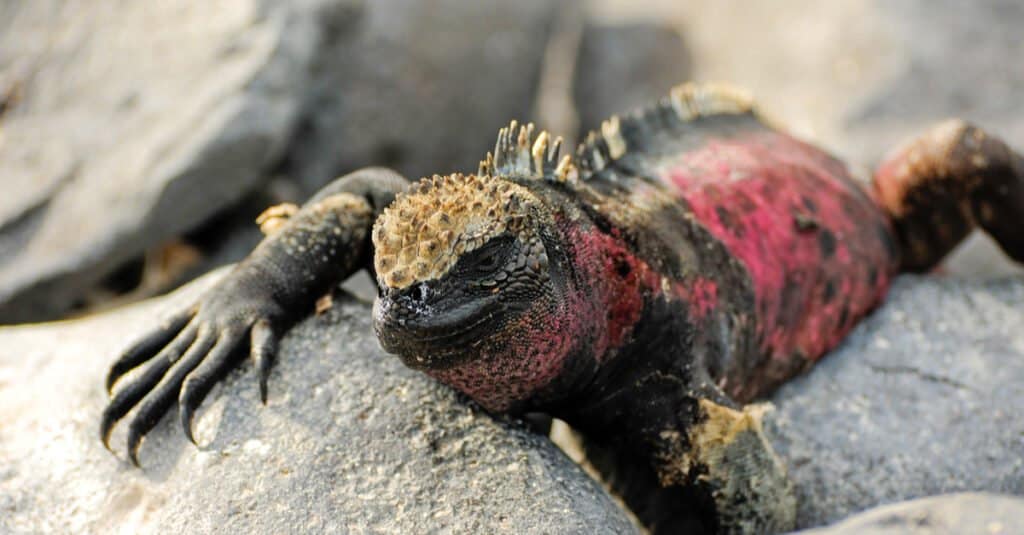
Iguanas can also have pink colorations
©Wirestock Creators/Shutterstock.com
The Galapagos pink land iguana is a critically endangered species. It currently lives in one small area near the Wolf Volcano on Isabela Island, which is part of the Galapagos Islands. These reclusive, colorful iguanas are primarily a deep, rosy pink with slightly darker pinkish-brown stripes. As far as size goes, they commonly weigh around 10 to 12 pounds and reach lengths of 18 to 24 inches.
Incredibly, researchers only discovered the species as recently as 1986! Unfortunately, less than 200 individuals remain in the wild. However, researchers have proposed conservation efforts in recent years, in particular a captive breeding program to boost the species’ numbers.
7. Española Marine Iguana (Amblyrhynchus cristatus)
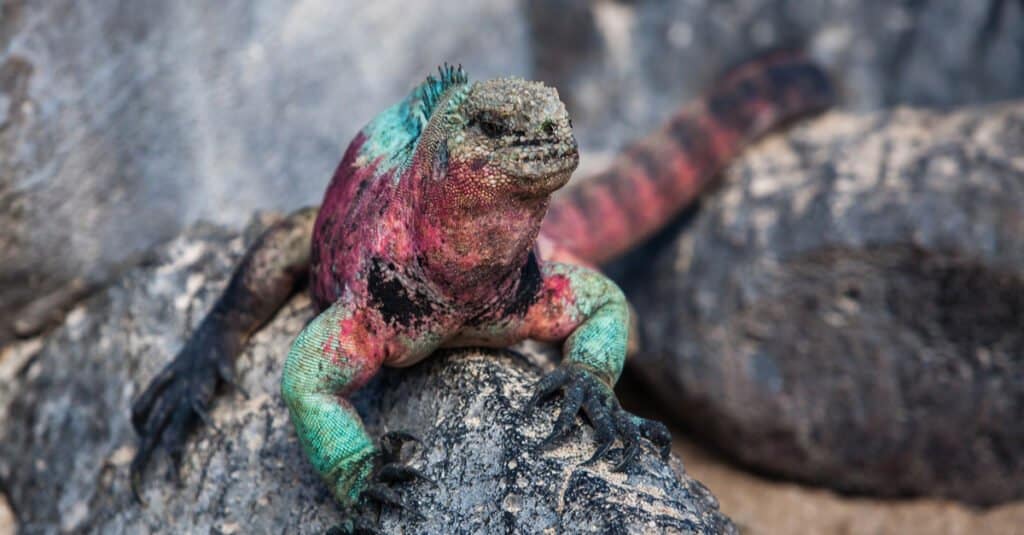
Unlike typical marine iguanas, those living on Espanola Island have a vibrant green and red coloration.
©npavlov/Shutterstock.com
The Española marine iguana is a specific type of marine iguana native to–you guessed it–Española Island, which is part of the Galapagos Islands. These particular iguanas have been dubbed by locals as “Christmas iguanas” due to their bizarre green and red coloring. By comparison, typical marine iguanas are mostly brown and grey in color.
The Española marine iguana’s coloration becomes even more vibrant during the lizards’ mating season. Other subspecies of this lizard also become more colorful to appeal to potential mates, too. For example, individuals on Fernandina Island also develop more greenish and red patches. However, none are quite as unique as Española Island’s own Christmas iguana.
8. Yellow-Backed Spiny-Tailed Iguana (Ctenosaura flavidorsalis)
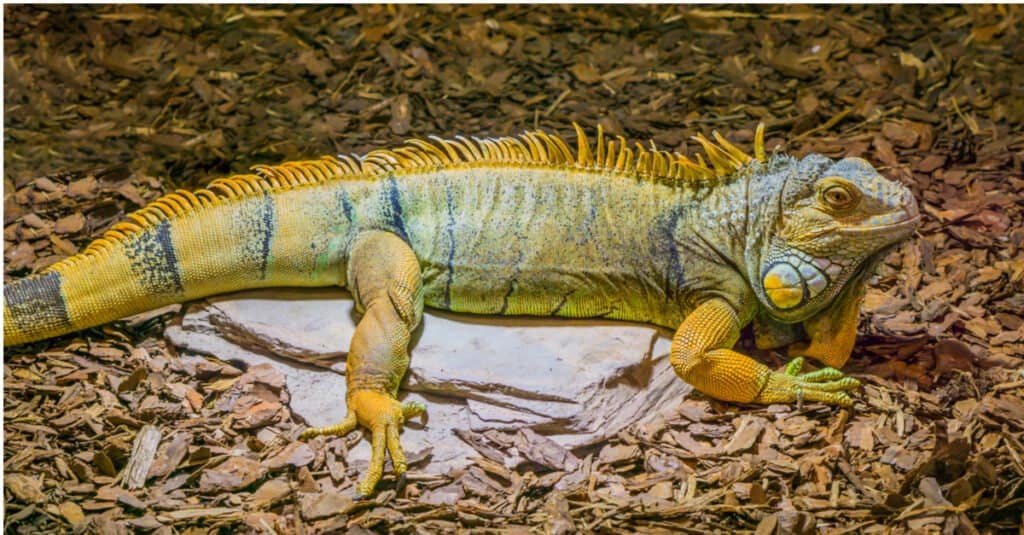
Yellow-backed
iguanas are becoming popular pets
due to their handsome coloration, small size, and long lifespan of 15 to 25 years.
©Charlotte Bleijenberg/Shutterstock.com
Another surprisingly colorful type of spiny-tailed iguana is the yellow-backed variety. While their bodies are primarily reddish-brown, their heads, necks, and backs have orange and yellow accents. In direct sunlight, these lizards are a sight to behold! They thrive in the hot, dry conditions throughout Central America.
Recently, they’ve even become quite popular in the pet trade thanks to their small size and surprisingly long lifespan. With proper care, these vibrant little iguanas can grow to be 15 inches long and live up to 25 years!
9. Fiji Crested Iguana (Brachylophus vitiensis)

Fiji crested iguanas are primarily green with thin, white stripes.
©iStock.com/Donyanedomam
Fiji’s islands are home to some unbelievably diverse and colorful wildlife, and the Fiji crested iguana is no exception! Similar to the aforementioned Fiji banded iguana, this lovely lizard stands out thanks to its emerald-green body color. In addition, individuals typically have thin white stripes across their midsections and tails.
Sadly, also like the Fiji banded iguana, the Fiji crested iguana has suffered significant habitat loss over the years. Today, it is a critically endangered species. However, conservationist groups have taken measures to repopulate them, such as protecting them from predators like cats and mongooses.
10. Lesser Antillean Iguana (Iguana delicatissima)
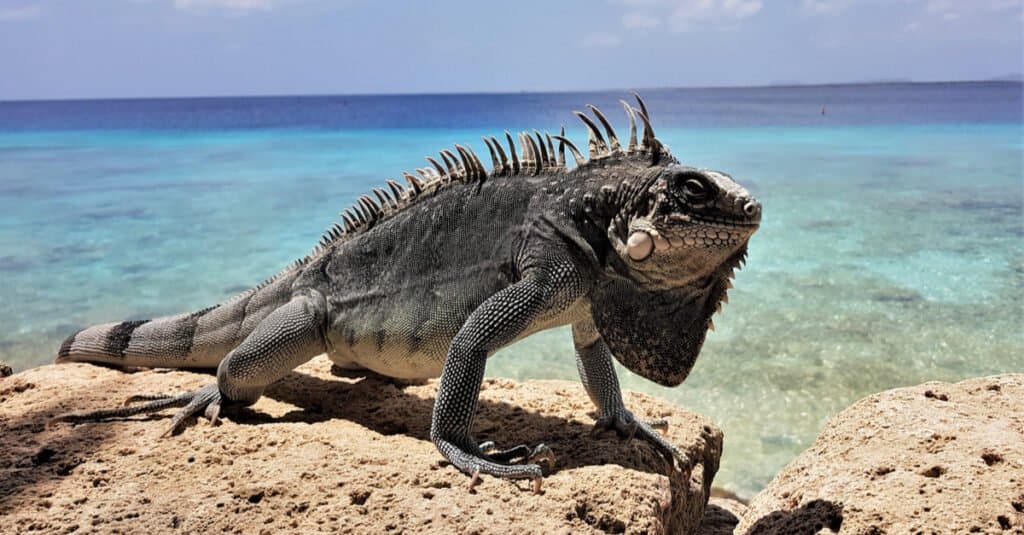
The Lesser Antillean iguana looks very similar to the green iguana
©Laura Jonker/Shutterstock.com
We finish off this rainbow of lizards with the handsomely colored lesser Antillean iguana, a close relative of the green iguana. Native to the Lesser Antilles, these iguanas look very similar to green iguanas in color, shape, and size, with a few key differences.
Lesser Antillean iguanas have shorter snouts and lack tail stripes typical of green iguanas. Their color is also a bit less vibrant in comparison, ranging from grey to greyish-green with green patches.
In addition, they are not nearly as abundant as green iguanas. In fact, they are currently critically endangered due to significant habitat loss and predation. They also unfortunately compete with green iguanas for resources, which has further accelerated their decline.
The photo featured at the top of this post is © npavlov/Shutterstock.com
Thank you for reading! Have some feedback for us? Contact the AZ Animals editorial team.



